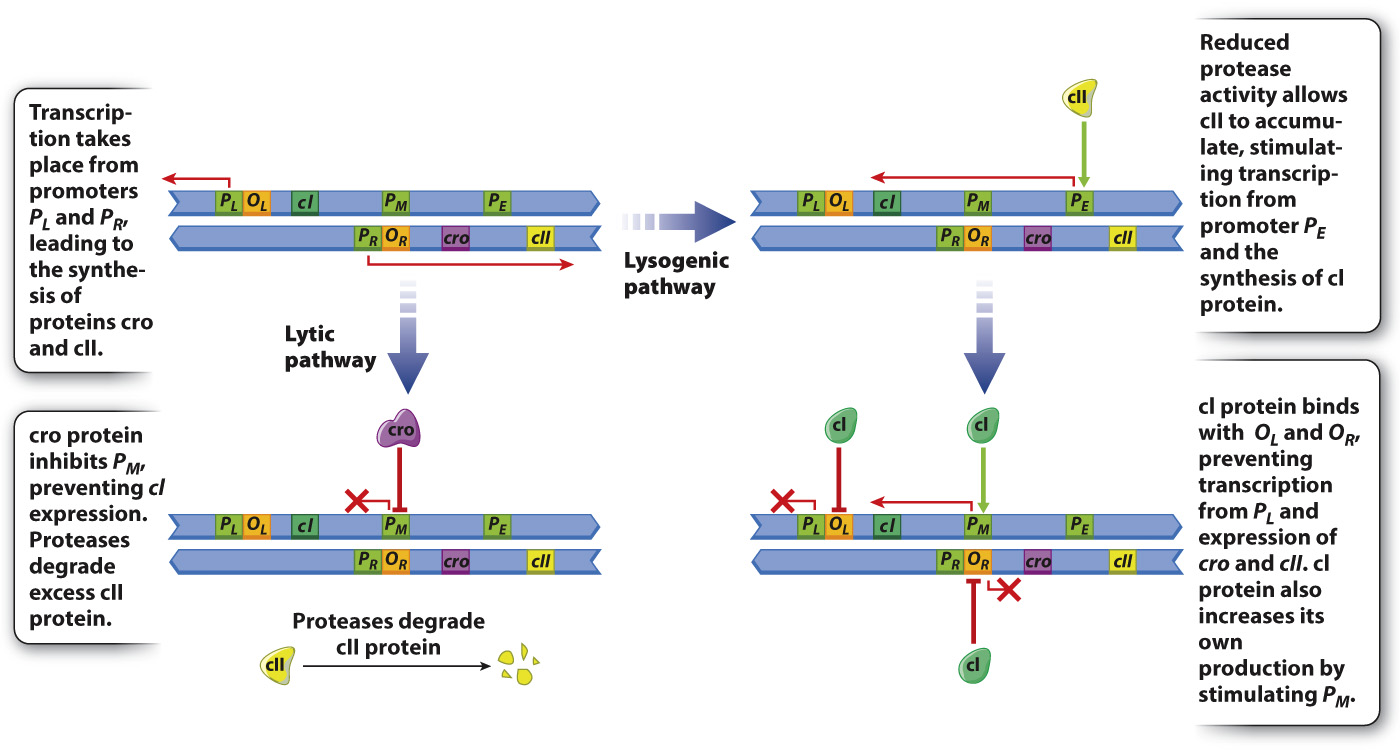Transcriptional regulation determines the outcome of infection by a bacterial virus.
Transcriptional regulation has also been well studied in viruses. Bacterial cells are susceptible to infection by a variety of viruses known as bacteriophages (“bacteriophage” literally means “bacteria-

Upon infection, the linear DNA of the phage genome is injected into the bacterial cell, and almost immediately the ends of the molecule join to form a circle. In normal cells growing in nutrient medium, the usual outcome of infection is the lytic pathway, shown on the left in Fig. 19.20. In the lytic pathway, the virus hijacks the cellular machinery to replicate the viral genome and produce viral proteins. After about an hour, the infected cell undergoes lysis and bursts open to release a hundred or more progeny phage capable of infecting other bacterial cells.
The alternative to the lytic pathway is lysogeny, shown on the right in Fig. 19.20. In lysogeny, the bacteriophage DNA and the bacterial DNA undergo a process of recombination at a specific site in both molecules, which results in a bacterial DNA molecule that now includes the bacteriophage DNA. Lysogeny often takes place in cells growing in poor conditions. The relative sizes of the DNA molecules in Fig. 19.20 are not to scale. In reality, the length of the bacteriophage DNA is only about 1% of that of the bacterial DNA. When the bacteriophage DNA is integrated by lysogeny, the only bacteriophage gene transcribed and translated is one that represses the transcription of other phage genes, preventing entry into the lytic pathway. The bacteriophage DNA is replicated along with the bacterial DNA and transmitted to the bacterial progeny when the cell divides. Under stress, such as exposure to ultraviolet light, recombination is reversed, freeing the phage DNA and initiating the lytic pathway.
At the molecular level, the choice between the lytic and lysogenic pathways is determined by the positive and negative regulatory effects of a small number of bacteriophage proteins produced soon after infection. Which pathway results depends on the outcome of a competition between the production of a protein known as cro and that of another protein known as cI. If the production of cro predominates, the lytic pathway results; if cI predominates, the lysogenic pathway takes place.
Fig. 19.21 shows the small region of the bacteriophage DNA in which the key interactions take place. Almost immediately after infection and circularization of the bacteriophage DNA, transcription takes place from the promoters PL and PR. Transcription of genes controlled by the PR promoter results in a transcript encoding the proteins cro and cII. The cro protein represses transcription of a gene controlled by another promoter PM, which encodes the protein cI. In normal cells growing in nutrient medium, proteases present in the bacterial cell degrade cII and prevent its accumulation. With cro protein preventing cI expression and cII protein unable to accumulate, transcription of bacteriophage genes in the lytic pathway takes place, including those genes needed for bacteriophage DNA replication, those encoding proteins in the bacteriophage head and tail, and, finally, those needed for lysis.

Alternatively, in bacterial cells growing in poor conditions, reduced protease activity allows cII protein to accumulate. When cII protein reaches a high enough level, it stimulates transcription from the promoter PE. The transcript from PE includes the coding sequence for cI protein, and the cI protein has three functions:
- It binds with the operator OR and prevents further expression of cro and cII.
- It stimulates transcription of its own coding sequence from the promoter PM, establishing a positive feedback loop that keeps the level of cI protein high.
- It binds with the operator OL and prevents further transcription from PL.
The result is that cI production shuts down transcription of all bacteriophage genes except its own gene, and this is the regulatory state that produces lysogeny. (The protein needed for recombination between the bacteriophage DNA and the bacterial DNA is produced by transcription from the PL promoter before it is shut down by cI.) When cells that have undergone lysogeny are exposed to ultraviolet light or certain other stresses, the cI protein is degraded. In this case, cro and cII are produced again, and the lytic pathway follows.
Regulation of the lytic and lysogenic pathways works to the advantage of bacteriophage λ, but the process is not like something an engineer might design. That is because biological systems are not engineered, they evolve. Regulatory mechanisms are built up over time by the selection of successive mutations. Each evolutionary step refines the regulation in such a way as to be better adapted to the environment than it was before. Each successive step occurs only because it increases survival and reproduction.
We summarize these two alternative outcomes of infection by a bacterial virus, and the earlier discussions of viral diversity, replication, host range, and effects on a cell, in Fig. 19.22.
VISUAL SYNTHESIS
